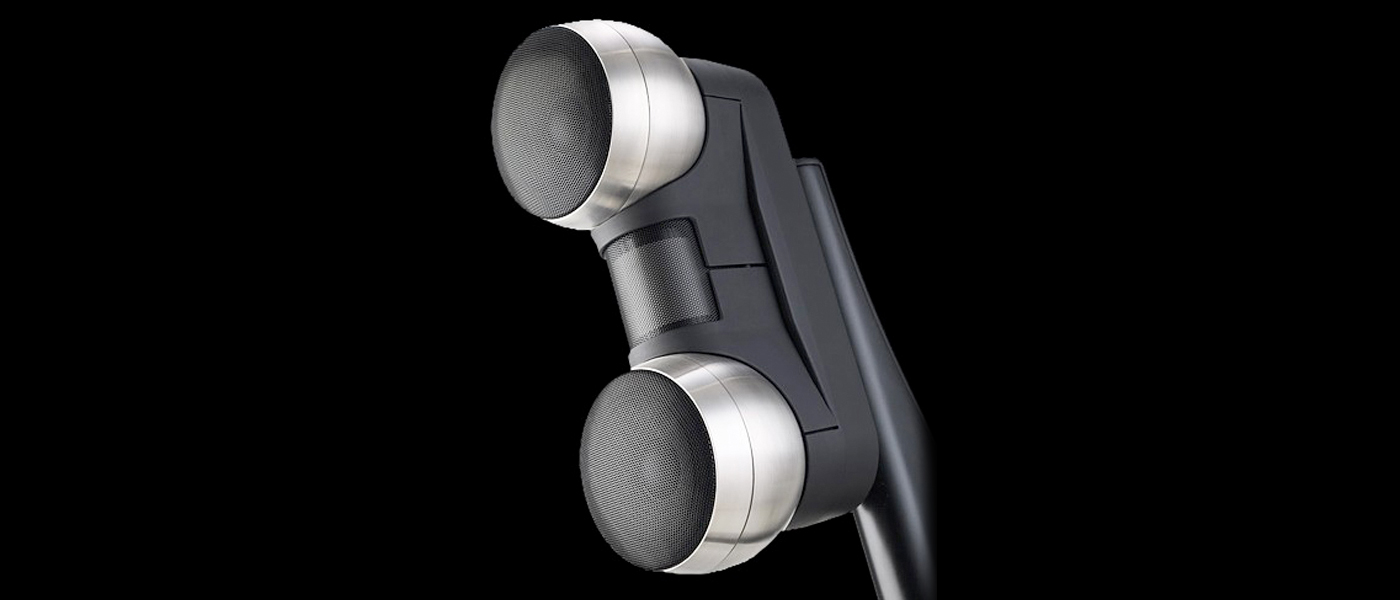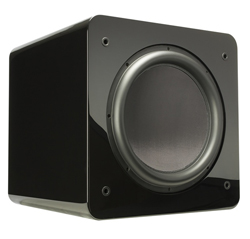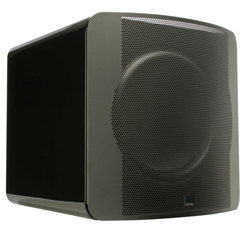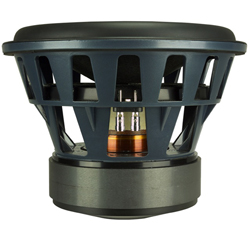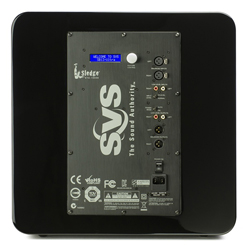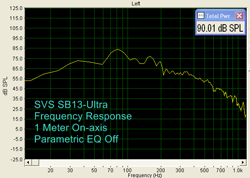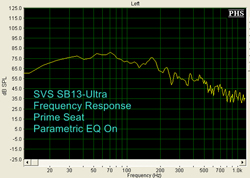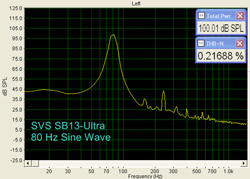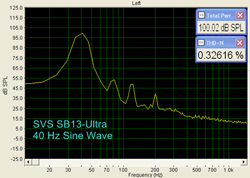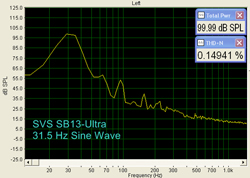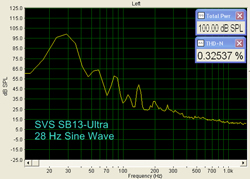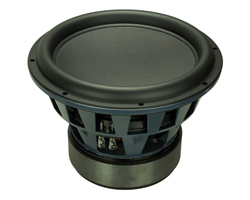Introduction to the SVS SB13-Ultra
The SVS SB13-Ultra powered subwoofer features a 13.5″ driver with 50mm peak excursion. It is driven by a 1,000 watt RMS Class D amplifier (3,600 watts peak). This amp has a dual band parametric equalizer and a unique limiter circuit that retains dynamic shadings even when pushed hard. The sub is a sealed box design with tight and clean bass. In fact, my nearfield THD+N (1 foot) measurements were all under 0.33% from 28 – 100Hz at 100dB!
SVS SB13-ULTRA SUBWOOFER SPECIFICATIONS
- Design: Sealed Enclosure
- Driver: One SVS 13.5″ High-performance Ultra Driver Optimized for Sealed Enclosures
- Amplifier: 1,000 watts RMS Continuous (3,600 Watts Peak), Class D
- MFR: 20 Hz – 460 Hz, ± 3 dB
- Inputs: 2 RCA Unbalanced and 2 XLR Balanced
- Outputs: 2 RCA Unbalanced and 2 XLR Balanced
- Dimensions: 17.9″ H x 17.4″ W x 20.4″ D
- Weight: 92 Pounds
- Finishes: High Gloss Piano Black or Black Oak Real Wood Veneer
- MSRP: $1,599 USD
- SVS
- SECRETS Tags: SVS, Subwoofers, Audio
Design of the SVS SB13-Ultra Subwoofer
The SVS SB13-Ultra is a fairly compact, high output sealed box subwoofer. Subwoofers can be designed in any number of ways but the two most common design concepts are either ported (bass reflex) or a sealed box (acoustic suspension). Ported subs tend to have a lower tuning frequency and a faster roll off below the tuning frequency while sealed designs normally have less extension but with a gentler roll off. In the hi fi and home theater belief systems, ported subs are considered higher output and less precise in their reproduction. They are generally viewed as optimal for movie effects while sealed subs, with their “tighter” and more controlled response characteristics are considered the better choice for music systems.
But SVS wondered what it would take to develop a sealed sub that would exploit cutting edge technology to bring you the best of both design concepts? Thus the SVS SB13-Ultra was born.
The SVS SB13-Ultra has been designed from the ground up to be a high quality and high performance compact subwoofer. The engineers at SVS call this a “Fully Optimized Design” which means they considered every aspect of the system – driver, amplifier and cabinet in order to achieve the optimal performance objectives.
The SVS SB13-Ultra is roughly an 18″ cube. Don’t be fooled by its smallish footprint as this bad boy clocks in at 92 pounds net! This may well be the densest subwoofer I have ever had in my system. I was able to load and unload the box from my car. I also singlehandedly unboxed the subwoofer and wrangled it into position in my listening room. That will be that last time I do that. A quality hand truck is now at the very top of my shopping list!
SVS told me that there are two major keys to making a great sealed box subwoofer – lots of clean power and lots of cone excursion. Let’s start with a breakdown on the driver. It starts with a 13.5″ Rohacell-backed pulp and fiberglass layered cone. The motor sports a 43 pound magnet structure. The 3″ diameter voice coil is bifilar wound to reduce impedance. This voice coil sports dual 9″ spiders that are spaced ¾” apart. This prevents rubbing or twisting of the voice coil. The driver features a gap extension plate to balance the force/displacement curve in the forward stroke direction. Additionally, the voice coil assembly is designed so it can’t “bottom out”. The stitched surround has a parabolic cross section. The whole assembly is supported by a die-cast aluminum basket.
So what does all this jargon mean to you, the consumer? It means that this sub’s driver has a very light and stiff cone. The motor can handle gobs of power in a controlled fashion with a peak excursion of 50mm! In the end, you can rest assured that you are getting substantial, linear output capabilities and very low distortion.
The conservatively rated Class D plate amp produces 1,000 watts RMS with a peak rating of 3,600 watts. It has a built-in control circuitry that is tailored to the system’s response. In this regard, SVS fully exploits one of the primary advantages of a powered speaker design – the ability to closely match the amplifier to the system. Furthermore, a high pass filter is not required for protection due to the sealed box design.
SVS has designed a unique limiter circuit for their subwoofers. Most limiter circuits chop off the first dynamic peak but let the tail end of a given passage come through at full power. SVS’s limiter circuit is is different. It is designed to equally attenuate each section of a passage, thereby retaining the dynamic shadings of the music.
The amp has a (manual) dual band parametric equalizer, room gain compensation control with adjustable frequency and slope along with adjustable digital delay on the main speaker line-level outputs to time-align the speakers and subs. All this is controlled by a single rotary knob and rear-panel LCD display.
The grille is a heavy duty perforated steel cage that is a perfect aesthetic fit with the subwoofer’s extreme image. The sub is available in either black ash or gloss black. My review unit was gloss black. The quality of the finish was exemplary.
Setup of the SVS SB13-Ultra Subwoofer
SVS shipped me the SB13-Ultra review unit via FedEx. I was busy at the office so I went online and requested FedEx to hold the package at my local FedEx Office location. A few days later, I borrowed my wife’s SUV and headed over to pick up the subwoofer. The lady who brought it out from the back room had a pensive and wry look on her face when she turned to look at me. Why? Well, it’s because the box weighs over 100 pounds! I was still able to lift it into the back of the car and unload it by myself without getting hurt or dropping the sub. But I’ll get some help moving the sub the next time because it is much heavier than it looks.
Assembly of the sub was a breeze. It comes with four conical feet that you screw in. You then place the sub in the proper spot, connect the signal cable(s), connect the included detachable power cord and install the heavy duty metal grille.
This amp has a full suite of line level inputs and outputs. These include both balanced and unbalanced stereo inputs and outputs. There are no speaker level inputs.
The STA-1000D Sledge amplifier is highly flexible. It is controlled through a rotary knob and a two-line backlit LCD display. There are eight available functions that allow configuration and control of the subwoofer. (I do wish that the display were on the front of the cabinet as I had to read it upside down and backwards.) The functions include:
Volume (dB)
High Pass Filter Adjustment (on/off, frequency and slope)
Low Pass Filter Adjustment (on/off, frequency and slope)
Phase (0° – 180°)
High pass delay (ms)
Room compensation (on/off, frequency and slope)
Sub mode (sealed, 16 Hz or 20 Hz)
Parametric EQ (2 filters, frequency, level and Q for each)
I put the sub in the front left corner of the room and connected a single unbalanced interconnect from the sub output of my Marantz AV7005 surround processor to the right channel input of the SB13-Ultra. After adjusting the volume and phase of the sub, I used it in this configuration for a few days until I was ready to dial in the sub’s EQ.
I calibrated the sub’s dual band parametric equalizer using a Radio Shack SPL Meter, a CD with one-third octave test tones, a notepad and a pen. I started by making a quick grid on the sheet that showed each tone and the published correction factor for my SPL meter.
I then ran through the tones, recorded the measured level, calculated the actual response and took a first stab at the correction I would need. Rooms tend to have both peaks and nulls and it is advisable to simply focus on attenuating any peaks you measure as nulls can be like black holes, absorbing so much energy that you will quickly overload your subwoofer trying to fill in the suckout.
So I focused on two strong peaks in the response. It took me a few iterations to get the right attenuation and Q for each peak. All told, I finished this exercise in about half an hour. I am pretty certain less experienced users will take longer at this, but it was largely a matter of simple trial and error until you get it right.
From this point on, I did not use the room correction software in my SSP. I simply used the sub’s EQ, manually setting the speaker distances and levels. I set all satellites to small and toggled the high pass between 80 and 90 Hz until I ultimately decided to leave it at 80 Hz for all my subjective discussions in the next section.
One last point; the amp has room gain compensation that attenuates the deep bass in smaller rooms. I did not use this control as my room is rather large. But it is a nice touch for SVS to include this feature which helps with bass integration in rooms less than 2,400 cubic feet.
The SVS SB13-Ultra Subwoofer In Use
I often find it difficult to integrate subwoofers into my system. This is normally due to any one of a number of reasons. Probably the most common reason is that a lot of subs have peaky response. When they do, I have to keep fiddling with the level turning it up and down until the balance seems right. Anytime I switch sources (or discs even) then I need to adjust it again striving for a subliminal blend. A lot of times, I can never get a good blend between a subwoofer and the satellites.
Some subs may have flat response, but they impart their own character to the bass. This is most often in the form of distortion. It doesn’t really matter if this distortion originates from the amplifier, the driver, port noise or from a poorly designed cabinet. All that matters is that a majority of subwoofers have a characteristic sound that further complicates the task of blending them with the main speakers.
The SVS SB13-Ultra handles both of these points as well as any sub I have evaluated in the last several years. This is evidenced by the bench tests in the next section. But I could hear the differences long before I ran the measurements. I could hear the very flat response of the SB13-Ultra. Plus, this sub’s extremely low distortion and sealed cabinet provided a most accurate sound with minimal overhang. It wasn’t dry, it was just plain accurate. As a result, I got superior integration of the sub. This also meant that I could turn up the bass, get a better sense of slam and the sub didn’t stand out too much. Add to that the super powerful amp that means you don’t have to worry about overload and you simply have one hell of a great product.

The first material I evaluated was the Diana Krall Blu-ray “Live in Rio”. I listened to the DTS HD Master 5.1track this time around. Diana Krall always attracts the best musicians to play with her. For this live performance, her band shares the stage with a small orchestra that performs on a number of tunes, but I prefer the parts of this disc where she is playing with the smaller jazz ensemble.
As discussed above, the parametric EQ provided an excellent blend. As a result John Clayton’s runs on his upright bass held together across the transition from the sub to the satellites. The SB 13-Ultra laid down a rock solid and steady foundation to the music with nary any hint of peakiness. I didn’t hear any of the far too common effect of the bass sounding like a detached entity. And the bass was nuanced throughout each track. This was indeed a very good beginning to my evaluation.
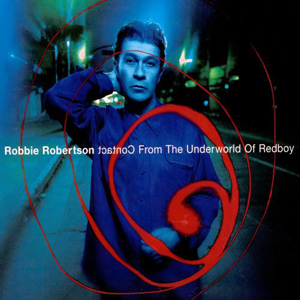
The next piece I used was the redbook CD by Robbie Robertson – “Contact from the Underworld of Redboy”. I listened to this disc in Dolby PLII Music mode. This CD is mixed with copious amounts of synthesized bass.
The SB13-Ultra underpinned the sound better than any sub I’ve had in my system in the last 5 years. It revealed all the life and nuance in the very low bass. By contrast, lesser subs may put out plentiful bass energy but it can be more of a formless mass that smears the bass texture recorded on the disc. Even though the bass on this disc is dominated by synthesizer, there is plenty of transient information and the SVS preserved the dynamic integrity of the bass lines.
The SB13-Ultra has tight bass response with a natural decay and very little overhang. This contributes to great timing. This was most evident with tracks like “Sacrifice” and “Rattlebone” where the bass rolled along at the appropriate pace and in time with the mid and upper registers.
This sub could also dig deep. Take “Peyote Healing” for example. This song has the lowest bass pulses on the disc. They were very clean through the SVS. These pulses were largely felt, not heard.

Another disc with a ton of low bass energy is the SACD of Sting’s 1999 solo album “Brand New Day”. I listened to the 5.1 channel layer. As a reviewer, I have become a little spoiled with clean low bass over the years so I was sort of taken aback by the even stronger, cleaner output from the SB13-Ultra when compared to other subs in its class.
It made me think of a friend of mine who used to play sax with Bob Seger. He said their engineer would tell him that he knew he had the bass right when he could feel it in his chest. Well, on “Brand New Day” I could really feel it in my chest – believe you me. On top of that, the SB13-Ultra revealed low bass on this disc that most subs just cut off. As before, the bass pacing was exemplary so bass lines didn’t lag like some subs (despite the very deep extension).

Well I would be remiss to conclude this review without evaluating a cinematic piece. How about “Dark Knight Rises” for a movie with some bombastic moments? This is a rockin’ action flick with kick ass bass throughout – the SVS brings out the best in it too. A common complaint with this movie is that Bane’s voice can be difficult to understand. With the SVS SB13-Ultra, I heard every line from Bane loud and clear.
When Batman flies away from cops at the end of the stock exchange scene, the walls of my room were literally bowing from the stress. Later, the big explosions during the stadium attack scene were full-throated and well controlled. I personally attest that the SB13-Ultra sub has nuance, power and slam all in one package.
The SVS SB13-Ultra Subwoofer On the Bench
All the below measurements were in-room response. The distortion measurements were performed on-axis in the near field (microphone 1 foot from the center of the driver) to mitigate any room boundary effects. The frequency response tests were typically performed at 1-meter on-axis with one exception as described below.
The plot above is the standard in-room frequency response test of the SVS SB13-Ultra. This test result showed serious boundary and room-induced modal effects.
To demonstrate the level of performance possible with the SVS SB13-Ultra, I ran an additional test from the prime listening seat with the parametric EQ engaged. The above plot indicated a response curve of +/-5dB from 20–100Hz. As mentioned above, I was able to get this frequency response in about 30 minutes with a pen, a notepad, a Radio Shack SPL meter and a CD with test tones. Not bad at all!
At 80Hz and 100dB, the distortion (THD+N) was inaudible and measured only 0.22%.
Tested at 40Hz, the distortion rose slightly but was still remarkably low at only 0.33%.
The 31.5Hz plot was also clean and the measured THD+N was even lower at just 0.15%.
The measured THD+N at 28Hz was another very clean plot at only 0.33%. This was measured at 100dB as well. Below 28Hz, the distortion rose rapidly, but the sub was still capable of substantial output to 20Hz, albeit with a much higher measured distortion.
Conclusions about the SVS SB13-Ultra Subwoofer
The SB13-Ultra was designed by Mark Mason who joined SVS in 2011 after a long stint as a Design Team Manager at PSB. Mark has developed several subwoofers and full-range speakers for SVS since making the move.
I personally like the design approach he took with the SB13-Ultra. It plays loud and deep with extremely low distortion. But it also has the ability to deliver finely nuanced bass with textures and dynamic shadings that are quite rare even by today’s standards. It consequently integrates well with the rest of your system allowing you to crank it up a little and really plumb the depths as they say. It is quite frankly and engineering juggernaut.
I haven’t upgraded my sub in over five years. Until now, that is. I am buying the review unit. Pretty sure I’ll hang on to this one for a while – it sounds great, it’s compact and it looks very manly – arrggh, arrrggh!


